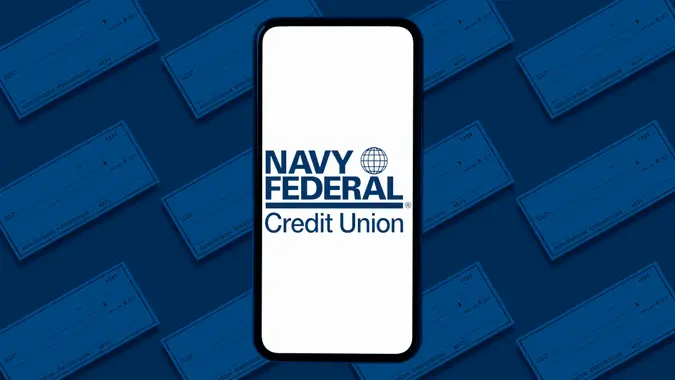What Is a Shared Branch Credit Union? Pros, Cons and How It Works

Commitment to Our Readers
GOBankingRates' editorial team is committed to bringing you unbiased reviews and information. We use data-driven methodologies to evaluate financial products and services - our reviews and ratings are not influenced by advertisers. You can read more about our editorial guidelines and our products and services review methodology.

20 Years
Helping You Live Richer

Reviewed
by Experts

Trusted by
Millions of Readers
Credit unions are non-profit, member-owned financial institutions that tend to offer their members extra perks that traditional banks don’t. Credit unions often provide higher savings rates, lower fees and other perks — but if you travel or move frequently, you may want the convenience of a shared branch credit union.
What Is a Shared Branch Credit Union?
Shared branch credit unions give members nationwide access to services at other participating credit unions, just like they would at their own home branch. This means that you don’t have to go to your own credit union to handle banking transactions.
For example, if you need money from your savings account while on an out-of-state road trip far away from your own credit union, you can head to a shared branch to withdraw the cash.
How Does Shared Branching Work?
A participating credit union within a shared branch network can process guest members’ transactions securely and seamlessly. The transactions go through as if the members had used their own credit unions.
Here’s how it works:
- The shared branch essentially asks your home credit union for permission to conduct the transaction.
- Your home credit union either grants or denies that permission.
- If it grants permission, the shared branch completes the transaction and then sends information about it to your home credit union.
- Your home credit union then updates your account.
- This process is fully digital, so the update happens instantaneously.
What Members Can Do at a Shared Branch Credit Union
- Deposit cash and checks
- Withdraw money
- Make loan payments
- Transfer funds between your own accounts
- Purchase money orders and traveler’s checks
- Get a cashier’s check
- Print statements
Shared Branch Credit Union: Pros and Cons
The basic premise of shared branch credit unions is relatively straightforward. Here’s a closer look at the benefits and drawbacks.
| Pros | Cons |
|---|---|
| Access to financial services at thousands of shared branches | Limited services — can’t open or close accounts at shared branches |
| Helps credit unions keep rates competitive by sharing resources | Service availability varies by branch (e.g., cashing checks, loan payments) |
| More no-fee ATMs available through expanded networks | Some branches may have long waits, especially in busy areas |
| Keeps loan and deposit rates competitive due to lower overhead | May require sharing personal information with non-home branch tellers |
How To Find a Shared Branch Credit Union
To find a shared branch, check the branch location page on your credit union’s website page, or contact your credit union directly. Alternatively, check the website of the network, if you know it.
The Co-Op Shared Branch network gives you access to over 5,600 shared branches. You can use the locator page on its website or the mobile app to locate shared branches and ATMs.
Pro Tip
Have the name of your home credit union, your account number and a photo ID handy when you arrive at the shared branch.
Shared Branch Credit Unions vs. Traditional Banks
Traditional banks and shared branch credit unions may seem similar in offering access to multiple locations, but they operate differently.
Here’s a side-by-side comparison:
| Shared Branch Credit Unions | Traditional Banks |
|---|---|
| Allow members to access basic services at any participating credit union nationwide | Allow customers to complete all transactions at any branch, regardless of where they opened the account |
| Typically have 5,600 or more branches through networks like Co-Op Solutions | Often have fewer location — for example, Chase has about 5,110 branches |
| As member-owned nonprofits, credit unions tend to offer lower loan rates and higher deposit rates | As for-profit institutions, banks generally charge higher loan rates and may offer lower deposit rates |
Who Should Use Shared Branching?
If you are deciding between a credit union that offers shared branching and one that doesn’t, the choice tends to come down to convenience.
- If you plan on using the in-person services on a regular basis, the expanded geographic footprint offered through shared branching is enticing.
- If you primarily plan on taking advantage of your credit union’s online banking features, then the expanded network of physical branches might not represent too much value.
- Another reason to choose shared branch credit unions is for frequent domestic traveling. If you are on the road regularly, access to a fee-free ATM can make a big difference.
Final Take
Some of the best credit unions participate in shared branching. This perk gives members more geographic flexibility when mapping out their financial services.
If you are already a member of a credit union, the easiest way to find out about shared branching privileges is by asking. Your credit union representative should be able to provide the details of any shared branching privileges.
If you prefer to avoid a phone call, scope out your credit union’s website for information about shared branches.
FAQ
Here are the answers to common questions about shared branch credit unions.- What is a shared branch credit union?
- A shared branch credit union is one that allows you to access financial services at a different credit union's physical branch. Most credit unions participate in a shared branching service of some kind.
- What services are available at shared branch locations?
- Common services at shared branches include the following:
- Cash and check deposits
- Cash withdrawals
- Loan payments
- Purchase of money orders, traveler's checks and official bank checks.
- Common services at shared branches include the following:
- Are there fees for using shared branch services?
- No. Shared branches don't charge guest members for using their services.
- How do I find a shared branch near me?
- Visit the branch locator page on your credit union's website, or contact your credit union's customer service department.
- Can I open a new account at a shared branch location?
- No. Shared branches can't open or close accounts held by other credit unions.
Sarah Sharkey contributed to the reporting for this article.
Our in-house research team and on-site financial experts work together to create content that’s accurate, impartial, and up to date. We fact-check every single statistic, quote and fact using trusted primary resources to make sure the information we provide is correct. You can learn more about GOBankingRates’ processes and standards in our editorial policy.
- UsNet. "FAQs."
- Statista. 2024. "Leading banks in the United States in 2024, by number of branches."
 Written by
Written by  Edited by
Edited by 

























